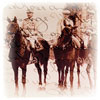Wesley Garrod, MM, was born in Ispswich, England, in November 1891, and sometime prior to the war he immigrated to Brownlee, Saskatchewan. Garrod enlisted in Moose Jaw, Saskatchewan, in January 1916. He served overseas as a corporal with the 2nd Canadian Mounted Rifles Battalion and was awarded the Military Medal for bravery. Garrod was killed in September 1918. The collection consists of one letter from Garrod to his brother.

Title
WWI
These collections contains any material relating to Canada from 1914 to 1918 from either the home front or the battlefront. External links in collection descriptions are either to online attestation papers at Library and Archives Canada or casualty and burial information at the Commonwealth War Graves Commission.
Private Thomas Garton was born in Huron, Ontario, on August 16, 1887, to parents George and Mary Garton.
Garton enlisted in Clinton, Ont., with the 33rd Battalion on January 14, 1915. He shipped overseas on the S.S. Scandinavian in June of 1915. Following several weeks training in England, he was posted to France to join the 1st Battalion on August 8. Wounded in action September 24, 1916, he died later the same day at No. 3 Casualty Clearing Station. Garton was buried at Puchevillers British Cemetery, Somme, France.
Content notes:
The majority of the collection’s letters were written by Garton to his friend Maudelean (“Maudie”) Carter of Clinton, Ont., between June 1915 and December 1916. Among the other materials are several French souvenir-type silk postcards, and a keepsake pamphlet from the S.S. Scandinavian summarizing voyage information.
Note on rank: Garton was ranked as a Private at the time of his death but had also previously been a Lance Corporal; as such both ranks are variously used within in the collection materials.
External links:
Pte. Thomas Garton’s service record (Serv/Reg# 400146) can be viewed/downloaded through Library and Archives Canada.
WWI Circumstances of Death Registers record card (page #769), Library and Archives Canada.
Burial information is available at the Commonwealth War Graves Commission.
A memorial page honouring Garton can be visited online at the Canadian Virtual War Memorial.
External links for other identified soldiers appearing in Garton’s letters (most were from or enlisted at Clinton, Ontario):
Pte. James Spearpoint, service record (Serv/Reg# 53737); killed in action August 29, 1918.
Pte. Delbert Huller, service record (Serv/Reg# A335 and 654344).
Pte. Thomas Israel Britton, service record (Serv/Reg# 1400686 and 880614).
Pte. Harold Vernon Mennel, service record (Serv/Reg# 02889 and 400135); died February 21, 1919.
Pte. George Bezzo (aka William Chester Bezzo), service record (Serv/Reg# 7119).
Pte. Milton Rintoul (aka Milton James Garton, James Milton Garton) service record (Serv/Reg# 158171).
Robert Andrew Garvie was born in Owen Sound, Ontario in November 1887. Prior to the war the family moved west, and Garvie was recruited at The Pas, Manitoba in October, 1917. He served overseas with the 9th Battalion Canadian Engineeers, was wounded in September, 1918 and returned to Canada in 1919. The collection currently consist of an undated memoir and two photographs.
Clarence Reginald Gass was born in Bayfield, Nova Scotia in April, 1894. He enlisted in Halifax in November, 1915 and served overseas until the end of the war. The collection consists of more than forty letters, as well as photographs, telegrams and miscellaneous items related to the 85th Canadian Infantry Battalion (Nova Scotia Highlanders) with whom he served.
William Vincent Gauthier was born in North Rustico, Prince Edward Island in October, 1897 and enlisted in Charlottetown in 1915. Gauthier served oveseas Enland, France, and Belgium until his return to Canada at the end of the war. The collection consists of a memoir written by Gauthier sometime after the war.
Lance Corporal Ralph Milton Gibson was born in Petrolia, Ontario, September 16, 1893 to parents John and Helena Gibson. He enlisted on December 20, 1915 in Montreal, Quebec with the 5th Overseas Universities Company (McGill Co.). Gibson sailed to France on April 1, 1916 aboard the S.S Olympic, arriving in England on April 11, 1916. On June 7, 1916 he was sent to France, where he joined the Princess Patricia's Canadian Light Infantry (Eastern Ontario Regiment). While serving with the PPCLI Gibson was killed at Vimy Ridge on April 9, 1917.
External links:
Lance Corporal Ralph Milton's service record (Serv/Reg# 487442) can be viewed/downloaded in pdf format through Library and Archives Canada.
Burial Information is available at the Commonwealth War Graves Commission.
A memorial page honouring Gibson can be visited online at the Canadian Virtual War Memorial.
Lance Corporal Ralph Milton's Circumstances of Death Register card can be viewed/downloaded through Library and Archives Canada.
James Reid Gillies was born in Dundee, Scotland, in October 1895 and immigrated to Canada in 1906. He enlisted in May 1917 in Winnipeg, Manitoba, and served overseas with the C.A.S.C. The collection currently consists of two photographs, a Christmas card, and his discharge certificate. See also the collection of John Gillies his brother.
John Gillies was born in Scotland in September 1882. He immigrated to Canada prior to the war and enlisted in July 1915 in Winnipeg, Manitoba, with the 78th Battalion. Gillies went overseas but was discharged in December 1916 on compassionate grounds, and died in Winnipeg in November 1918. The collection currently consists of three photographs and his discharge certificate. See also the collection of James Reid Gillies, his brother.
Albert James Gilmore was born in Wooster, Ohio in February, 1884. He later lived in Toronto, Ontario where he worked as a linotype operator for the Toronto Star. Gilmore enlisted in Toronto in August, 1915. He served overseas with the Canadian Field Artillery and was killed September 15, 1918. The collection consist of one letter, a photograph of Gilmore, and a newspaper death notice.
Born in 1889 in Ontario, Wilbert Gilroy studied dentistry and in 1911 moved to Winnipeg to take over a practice. He enlisted in Winnipeg in 1914 and was sent to France in 1915 with the Canadian Dental Corps. In 1917 Gilroy had himself attached to the Royal Flying Corps and flew with them during 1917 until wounded in October of that year. He returned to England and then subsequently to Canada where he continued to practice dentistry. The collection consists of 130 letters written from 1911 to 1917.
Major (Chaplain) Alexander MacLennan Gordon, DSO, MC, was born in Ottawa, Ontario, on May 26, 1873, to parents Dr. Daniel Miner Gordon and Eliza Simona Gordon (née MacLennan).
A Presbyterian clergyman, Gordon was serving as a member in the Non-Permanent Active Militia at the time of his mobilization for Active Service with the 5th Regiment, Royal Highlanders of Canada (R.H.C.), in Septemberr 1914. He attested at Valcartier Camp in Québec on September 23, 1914, and was appointed as Chaplain to the 13th Battalion, R.H.C.
Gordon embarked for England with the First Contingent that October, aboard the SS Alaunia. Proceeding to France with the 3rd Infantry Brigade in January 1915, he was then transferred to the No.1 Canadian Field Ambulance. In July of 1916 he was appointed as Senior Chaplain of the 4th Division, Canadian Chaplain Service.
Wounded in August 1918, Gordon was treated in England before being invalided back to Canada in June of the following year. He was demobilized in September 1919.
Content notes:
Gordon’s informative and expressive letters were written between October 1914 and April 1915. The earliest, written during his crossing to England aboard the SS Alaunia, is particularly notable for the amount of descriptive detail conveyed.
Among the family names appearing in the letters are references to Gordon’s brother Major George Huntly Gordon, OBE, (“Hunt”), his sister Wilhelmina Gordon (“Min”), and his father, Daniel Miner Gordon (“the Principal”), who was Principal of Queen’s University at that time. Mentions of “Canon Scott” are to Lt. Col. (Canon) Frederick George Scott, CMG, DSO, FRSC, noted poet and author of the 1922 memoir The Great War As I Saw It.
External links:
Major Alexander MacLennan Gordon’s service record (Serv/Reg# not assigned) can be viewed/downloaded in pdf format through Library and Archives Canada.
Major George Huntly Gordon’s service record (Serv/Reg# not assigned) at Library and Archives Canada.
Lt. Col. (Canon) Frederick George Scott's service record (Serv/Reg# not assigned) at Library and Archives Canada.
Major George Huntly Gordon, OBE, was born in Winnipeg, Manitoba, on November 16, 1882 or 1883 (both dates appear in his military records), to parents Dr. Daniel Miner Gordon and Eliza Simona Gordon (née MacLennan).
An engineer prior to the war, Gordon attested at Valcartier Camp in Québec on September 29, 1914, with the Canadian Army Service Corps (C.A.S.C.), and sailed to England as part of the First Contingent in October of 1914, aboard the S.S. Franconia. Following time spent at the front in Belgium and France with the C.A.S.C., Gordon returned to Canada, where the 4th Canadian Divisional Ammunition Sub-Park, C.A.S.C., was organized under his command, at Toronto, in April of 1916. They proceeded to England the following month, and later that August to France, with Gordon commanding what eventually became the 4th Canadian Divisional Mechanical Transport Company, formed in April of 1918 through the amalgamation of of No. 4 Canadian Divisional Supply Column and No. 4 Canadian Divisional Ammunition Sub-Park. Gordon survived the war, and demobilized in June of 1919.
Content notes:
The single letter in the collection was written by Gordon to his father on April 27, 1915, following the 2nd Battle of Ypres. Also included is a hand-written Nominal Roll of other ranks of the 4th Div., M.T. Co., C.A.S.C., from January of 1919.
Collection materials were donated together with those of Gordon’s brother, Major (Chaplain) Alexander MacLennan Gordon, DSO, MC, who served during the war with the Canadian Chaplain Service.
Spelling variants of both “Huntley” and “Huntly” appear in Gordon’s service file, and in his Library and Archives Canada record. However Gordon himself signs his Attestation Paper as “Huntly,” and this is the spelling used by his brother Alexander in his correspondence; as such it is the spelling used here.
External links:
Major George Huntly Gordon’s service record (Serv/Reg# unassigned) can be viewed/downloaded in pdf format through Library and Archives Canada.
Major Alexander MacLennan Gordon’s service record (Serv/Reg# not assigned) at Library and Archives Canada.
Cadet Douglas (“Dug”) Moncrieff Goudie was born in Liverpool, England, on May 8, 1895. Immigrating to Kamloops, British Columbia, prior to the war, he was a member of the Militia’s 102nd Regiment at the time of his enlistment with the 48th Battalion in Victoria, B.C., on April 19, 1915.
He shipped for England in July of 1915, and then to France in March of 1916 with the 3rd Canadian Pioneer Bn. (redesignation of the 48th Bn, January 1916). At his own request he transferred to the 29th Bn. in April of 1917. In July of the following year he joined the British Royal Air Force and was still in training as a Cadet when hostilities ceased (hence his final rank as “Cadet” in his service history, despite his previously held ranks of Private and Lance Corporal within the Canadian Expeditionary Force). Following his return to Canada he was demobilized at Kamloops on June 15, 1919.
The materials in the Goudie Collection were donated as part of the Sydney Winterbottom Collection. Goudie and Winterbottom had been friends in Kamloops before the war, and following Goudie’s transfer to the 29th Bn. in April of 1917, they served together in France until Winterbottom’s death at Passchendaele that November. In the letter section of the Goudie Collection is a letter that he wrote to their mutual friend Adrian Thrupp following Winterbottom’s death, as well as a reference list of links to the numerous letters by Winterbottom in which he writes about Goudie.
External links:
Cdt. Douglas Goudie’s service record (Serv/Reg# 430974) can be viewed/downloaded in pdf format through Library and Archives Canada.
Earle Shaw Grant was born in Hyndman, Ontario in September, 1896 and moved to Vancouver, British Columbia around 1907. Earle enlisted in July, 1917 with the Canadian Army Medical Corp, and then later transferred to the Royal Flying Corps. He survived the war and returned to Vancouver where he taught school. The collection consist of four photographs and an extended letter. The letter is comprised of type written excerpts from Earle's letters to his brother Harry, who compiled them in the present form.
Pioneer John Grant was born in Fort Augustus, Scotland, on October 19, 1886, to parents Charles and Margaret Grant. Prior to enlistment he was living in Ladysmith, British Columbia, working as a carpenter. He enlisted with the 1st Pioneer Battalion in Victoria, B.C., on September 22, 1915.
Arriving in England on November 30, 1915, Grant proceeded to France in March of 1916. He was killed in action on June 13, 1916, in the trenches between Ypres and Mount Sorrel. His body was never found and he is commemorated at the Menin Gate Memorial in Ypres, Belgium.
Grant’s name is listed on the Ladysmith Cenotaph along with forty other soldiers who were born, lived, or worked in Ladysmith, B.C., and who died during the First World War. Seven of these soldiers, including Grant, had wartime letters published by The Ladysmith Chronicle newspaper (see links below).
The complete list of soldiers in the can be found in the Ladysmith and District Historical Society collection.
External links:
Pioneer Grant’s Service Record (Serv/Reg# 154184) can be viewed/downloaded in pdf format through Library and Archives Canada.
Burial information is available at the Commonwealth War Graves Commission.
A memorial page honouring Grant can be visited online at the Canadian Virtual War Memorial.
Pnr. Grant is commemorated on the Menin Gate Memorial, Ypres, Belgium, and his name is inscribed on the Ladysmith Cenotaph, Rotary Memorial Peace Garden, Ladysmith, B.C.
A collection of WWI soldiers' letters published in The Ladysmith Chronicle was undertaken by the Ladysmith & District Historical Society through their work with the Ladysmith Archives.
William Edward Grassie was born in Smithville, Ontario in 1893 and was a student at Queen's University in Kingston, Ontario when he enlisted in March, 1916. He returned to Canada at the end of the war and taught high school in Port Credit, Ontario. The collection consists of two letters written to his friend Helen Davis. Other correspondents to Davis include the Daniel Austin Lane Collection, the Gordon Shrum Collection, and the Fred Nickle Collection.
Charles Robert Gray was born in Kent, England, in March 1891. Sometime prior to the war he immigrated to Canada and settled in Toronto, Ontario. Charles enlisted in Toronto in April 1915. After training in Canada and England he was sent to France. Charles was killed on June 3, 1916. Walter Henry Gray was the younger brother of Charles. He was born in Kent, England in June 1895. Sometime prior to the war he immigrated with his family and settled in Toronto, Ontario. Walter enlisted in Toronto in April 1915, the same day as his older brother. He served overseas with his brother and was seriously wounded in the same attack in June 1916 that killed his brother. He was discharged in December 1916 and returned to Canada. The collection consists of twenty five letters as well as several photographs. The original collection was donated by the Gray family to The Ontario Archives in Toronto.
Private John Gray was born in Old Meldrum, Aberdeenshire, Scotland, on April 13, 1874. The middle of nine children, John immigrated to Canada with his younger brother Edgar in 1903. Prior to his enlistment he was living in Oak Bay, Victoria, on Vancouver Island, British Columbia, with his wife Edith (née Dyson) and their four young children Alex Dyson, Olive Emmie, John Harvey, and Edna Jean. He worked as an upholsterer for David Spencers Co.
On March 23, 1916, he enlisted in Victoria with Canadian Army Medical Corps. Shipping for England on board the SS Olympic in July 1916, he was sent to the Cheriton C.A.M.C. Training Depot before proceeding to France in September 1916. On arrival he was transferred to the 2nd Canadian Stationary Hospital, C.A.M.C. where he served out the remainder of his time overseas until his demobilization on May 24, 1919.
The letters in the collection were written during the war by John Gray to his daughter Olive who would have been between the ages 5 and 8 at the time. The typed transcriptions of the diaries and notebook were done by Olive Collington (née Gray), most likely in the early 1990’s. In "Collection Contents" below the diaries can be read under the "Diary Entries" heading, and the notebook under "Memoirs"; Gray's "Active Service Canadian Pay Book" is under "Printed Matter."
External links:
Pte. John Gray’s service record (Serv/Reg# 524785) can be viewed/downloaded in pdf format through Library and Archives Canada.
Victor Arthur Green, DCM, was born in Kent, England, in January 1895. Green immigrated to Canada prior to the war and enlisted in Victoria, British Columbia, in November 1914 with the 88th Fusiliers. He was wounded three times, including at Vimy Ridge, and was awarded the DCM. The collection currently consists of sections of his pay book, telegrams, a newspaper clipping, several photographs, and an undated memoir of his service experiences.
Ralph Frank Greenard was born in Toronto, Ontario in December 1896. Greenard enlisted with the 103rd Battalion in Victoria, British Columbia in January 1916. His unit sailed for England in July 1916, and when in France he served in the 29th Battalion. He suffered a gun shot wound at Vimy Ridge on April 9, 1917, and after hospital treatments in France and England he returned to Canada in October 1917. He was discharged as medically unfit due to the complications of the wound. It would appear that in the confusion of the attack he was hit by one of his own machine guns from behilnd. For that information see his Medical Board sheet in the collection which can be found in his CEF Service File. The collection currently consists of one letter written while in hospital in May1917 as well as the information from the Medical Board.



